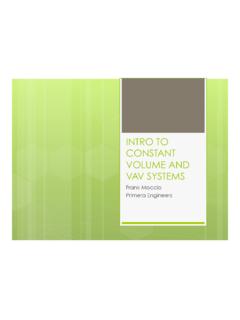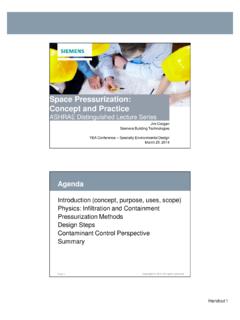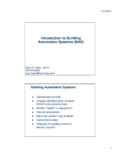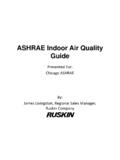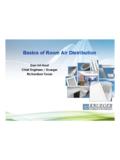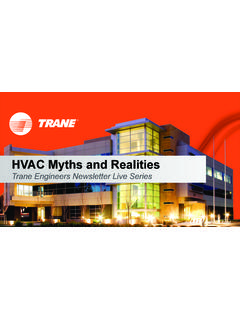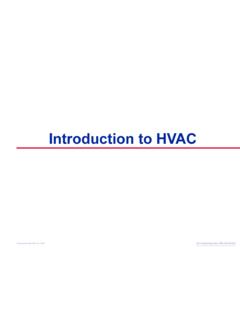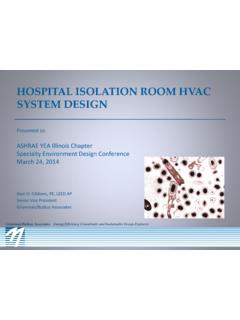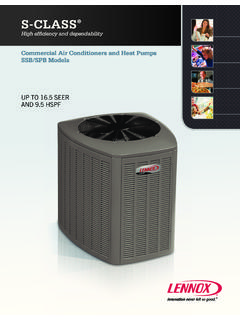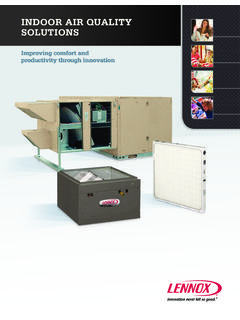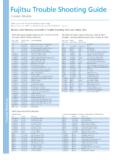Transcription of Variable Refrigerant Flow Systems vs. Geothermal Water ...
1 1 Presented by:Matt GreenVariable Refrigerant Flow Systemsvs. Geothermal Water Source heat Pump SystemsSection I: Case Study Northern Illinois Food Bank NIFB challenge/goal System choices considered System choice selected Results/awardsSection II: Comparing VRF Systems to GSHP Systems Comparison of system components Advantages of VRF Systems Capturing first cost savings with VRF Systems ConclusionsSection III: Northern Illinois Food Bank Building TourAgenda2 Section I: Case Study - NIFBNIFB Challenge/GoalThe Challenge:The Northern Illinois Food Bank needed a new facility to allowthem to continue their mission of preparing and distributing foodto over 60,000 hungry people each Goal:Design and construct a cutting-edge, energy efficient buildingon time & in budget to meet the future needs of the communitiesthe NIFB serves. The design team targeted LEED certification asan important requirement of the building s design andconstruction I: Case Study - NIFBS ystem Choices ConsideredTo meet the project s energy efficiency requirements, many Systems were evaluated.
2 The final two Systems considered for the office area were: Geothermal Water source heat pump (GSHP) system Air source Variable Refrigerant flow (VRF) system3 Section I: Case Study - NIFBS ystem Choice SelectedAfter careful consideration, VRF was selected as the winning system key advantages influenced the decision: Very little, if any, energy efficiency penalty to go with VRF Lower capital cost by approximately $400,000 VRF system qualified for a grant from a clean energy foundationOther innovative and efficiency Systems were used elsewhere, including: White roof technology Motion controlled lighting High performance glass Warehouse heating via waste heat from cooler/freezer systemsSection I: Case Study - NIFBR esults/AwardsProject Milestones:July 2010: Ground breaking ceremonyOctober 2011: Construction completedApril 2012: Building is awarded LEED -NC Gold certificationApril 2012: Building is awarded USGBC Illinois Chapter Emerald AwardEnd Result:The VRF system was a key component in helping the NIFB achieve their goals of constructing a cutting-edge, energy efficient facility on time & in budget.
3 In addition, the sustainable features inherent in VRF Systems contributed to the facility s LEED -NC Gold certification and Emerald II: VRF Systems vs. GSHP SystemsSystem Components - VRFI ndividual controls in each zoneTemperature set points Fan speedMultiple operating modes Condensing unit(s) (compressors)Multiple indoor unitsSingle piping systemVentilation served by separate systemSection II: VRF Systems vs. GSHP SystemsSystem Components - GSHPI ndividual controls in each zoneTemperature set points Fan speedMultiple operating modes Bore field (may have boiler/tower in hybrid system)Multiple indoor units(compressors)Single piping systemCirculating pumpVentilation served by separate system5 Section II: VRF Systems vs. GSHP SystemsSystem Components - SimilaritiesOn the surface, VRF and GSHP look very similar: Heating & cooling via Refrigerant based heat pump cycle Multiple terminal units located in, or near, occupied space High degree of zoning flexibility & individual temperature control Ventilation handled by separate DOAS systemUNDER CLOSER INSPECTION THERE ARE SIGNIFICANT DIFFERENCESS ection II: VRF Systems vs.
4 GSHP SystemsSystem Components - DifferencesDespite the similarities, there are key differences: In VRF Systems , compressors are centrally located in lieu of in/near the occupied space In VRF Systems , compressors are Variable speed in lieu of staged control In air source VRF Systems , no circulating pumps are required In air source VRF Systems , no bore field is required VRF Systems have more flexibility regarding terminal unit appearance & location VRF Systems are an integrated self contained control system. In many cases, no third party controls are required operate system. As compared with the many independent components (ie pumps, GSHP units, boilers/towers (if used), etc.) needed in GSHP II: VRF Systems vs. GSHP SystemsAdvantages of VRF SystemsThe previously discussed differences contribute to the following advantages of VRF Systems as compared to GSHP Systems : Improved maintenance/serviceability Improved system sound performance Improved dehumidification/temperature control Improved unit/system reliability Reduced capital cost Reduced life cycle costSection II: VRF Systems vs.
5 GSHP SystemsAdvantages of VRF Systems :Improved Maintenance/Serviceabilty Most GSHP Systems have multiple, small compressors scattered throughoutthe building. In large Systems , the number of compressors can easily be inthe 100-500+ range. This presents a significant challenge formaintenance/service personnel to properly maintain and service units. Most GSHP Systems have terminal units located in ceiling space withextremely limited (if any) service access clearances. To minimize downtime, spare chassis concept is utilized. VRF Systems utilize centrally located compressors for easeofmaintenance and service. EXAMPLE: Regional Hospital located in Elgin, IL 645,000 sq. ft. facility 255 patient rooms in 6-story tower 540 Water -to-air heat pumps in building =at least 540 compressors7 Section II: VRF Systems vs. GSHP SystemsAdvantages of VRF Systems :Improved System Sound Performance As previously stated, in GSHP Systems the compressors are often located inthe occupied space.
6 Compressors can generate significant noise andvibration, especially in large tonnages. To minimize noise related issues, designers have trended towards specifyingsound reduction packages/specialized vibration isolation mounting Systems (increased unit cost) or remote location of the GSHP unit (increasedinstallation cost). VRF Systems utilize centrally located compressors for easeofnoise/vibration attenuation. By utilizing Variable speedcompressorsand fans, VRF Systems are inherently quiet; in many cases, theydon t require any special TonnagePremium GSHP (w/sound attenuation)Ductless VRF EvaporatorDucted VRF Pressure Data (dbA)Section II: VRF Systems vs. GSHP SystemsAdvantages of VRF Systems :Improved Dehumidification/Temperature Control Most conventional GSHP heat pump Systems utilized staged compressors fortemperature control. Often, this results in wide swings in the spacetemperature and poor dehumidification. To combat excessive humidity build-up that can be problematic in GSHP Systems , complex DOAS Systems are utilized to treat the humidity at thesource.
7 By utilizing Variable speed compressors & electronic expansionvalves, VRF Systems provide precise space temperature and humiditycontrol. In some cases, only energy recovery ventilators arerequired in lieu of full DOAS pointtimetemperature8 Section II: VRF Systems vs. GSHP SystemsAdvantages of VRF Systems :Improved Unit/System Reliability As previously discussed, GSHP Systems can be subjected to less than idealmaintenance and service conditions. Both maintenance and service arecritical to system reliability. GSHP Systems are usually comprised of many small Refrigerant circuitsscattered throughout the building. Although factory testing is completed onthe units, experience has shown that the reliability of the units is less thandesired. By utilizing easy to maintain and service, centrally located variablespeed compressors, and rigorously tested and proven installationtechniques, VRF Systems have been shown to have exceptionalsystemreliability. While VRF Systems exhibit some characteristics ofcentralized Systems , their modularity and design provide II: VRF Systems vs.
8 GSHP SystemsAdvantages of VRF Systems :Reduced Capital Costs GSHP Systems require the land and labor/materials to drill bore holes intothe earth. In many cases the land required is not available; furthermore atapproximately $3,000/ton Geothermal field construction can be tooexpensive. Most GSHP Systems require a dedicated 20-30A power feed to each terminalunit, resulting in higher electrical installation costs. Most GSHP Systems require a 3rdparty Building Automation System (BAS) tocoordinate all of the various system components, resultingin highertemperature control installation costs. By utilizing an air source heat pump VRF platform, there is noneedfor the land/expense required with a Geothermal bore locating the compressors, a smaller number of larger powerfeeds are required, resulting in lower electrical installation , many VRF Systems do not require a BAS to operate thesystem. VRF Systems already include all necessary control devicesto coordinate the various systemcomponents, resulting lowertemperature control installation II: VRF Systems vs.
9 GSHP SystemsAdvantages of VRF Systems :Reduced Capital CostsVRF SYSTEM80 Room Hotel80 GSHP s 2 ton = 30 MOCP per unitPower service requirements 30 amp X 80 =2400 amp service for roomsVRF System20 8 ton VRF @ amps 20 X 50 amps = 1000amps80 Fan Coils @ .5amps 10 X 20 amps = 200amps1200 amp service for rooms Section II: VRF Systems vs. GSHP SystemsAdvantages of VRF Systems :Reduced Life Cycle CostHigh Reduced SustainabilityLower Total CostEfficiency Maintenance of Ownership++=10 Section II: VRF Systems vs. GSHP SystemsConclusions VRF Systems are an excellent alternative to decentralized GSHP Systems Air source VRF Systems can provide similar, or better, energy efficiency toGSHP systemswithoutthe expense of the Geothermal bore field VRF Systems can provide better sound performance VRF Systems can provide better temperature/dehumidification control VRF Systems can be more reliable and are easier to maintain/service VRF Systems are not a magic bullet, they should be applied where bestsuited.
10 Some buildings are good candidates for a hybrid approachintegrating multiple system III: NIFB Building Tour Lets see some equipment in operation11 Section III: SummaryTHANK YOUQ uestions?Primary ContactMatt Green, Sales EngineerOffice: 630-433-4204 Cell: 630-730-4917 Fax.

